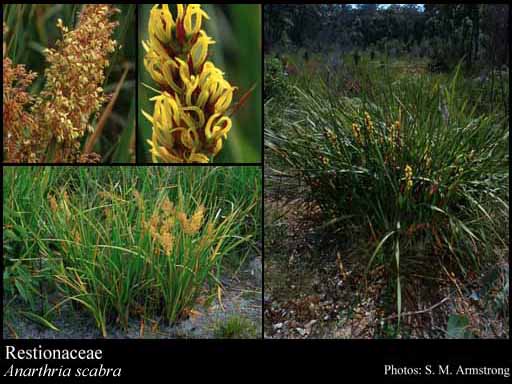- Reference
- Prodr.Fl.Nov.Holland. 243 (1810)
- Name Status
- Current







Scientific Description
Common name. Restio Family.
Habit and leaf form. Xeromorphic herbs, or herbaceous climbers; evergreen, or deciduous. ‘Normal’ plants to switch-plants, or plants of very peculiar form (female Alexgeorgia being almost subterranean); commonly with assimilatory stems. Leaves well developed, or much reduced (the blade being usually much reduced or absent). Perennial; plants with a basal concentration of leaves, or with neither basal nor terminal concentrations of leaves. Young stems cylindrical, or tetragonal, or flattened, or oval in section (or polyhedral); not breaking easily at the nodes. Stem internodes solid, or hollow. Rhizomatous. Self supporting, or climbing; sometimes scrambling. Xerophytic. Leaves alternate; distichous (usually), or spiral; leathery, or membranous; sessile; sheathing (and generally more or less reduced to the sheaths). Leaf sheaths with free margins. Leaves simple. Leaf blades when present, entire; when present, parallel-veined; without cross-venules. Leaves ligulate, or eligulate; with stipules (in the form of membranous lobes at the tops of the sheath margins), or without stipules; with a persistent basal meristem, and basipetal development. Vegetative anatomy. Plants commonly with silica bodies (usually in the bundle sheaths). Leaf anatomy. Leaf blade epidermis conspicuously differentiated into ‘long’ and ‘short’ cells, or without differentiation into ‘long’ and ‘short’ cells. Guard-cells variously not ‘grass type’, or ‘grass type’. Stem anatomy. Secondary thickening absent.
Reproductive type, pollination. Fertile flowers functionally male, or functionally female, or hermaphrodite, or functionally male and functionally female. Unisexual flowers present (usually), or absent. Plants dioecious (usually), or hermaphrodite, or monoecious. Female flowers with staminodes, or without staminodes. Male flowers with pistillodes, or without pistillodes. Floral nectaries absent (nectaries absent). Anemophilous.
Inflorescence and flower features. Flowers aggregated in ‘inflorescences’; in ‘spikelets’ (often), or not in ‘spikelets’. Inflorescences scapiflorous, or not scapiflorous; terminal; spikelike panicles, often compound, sometimes sexually dimorphic, sometimes with flowers aggregated in ‘spikelets’. Flowers bracteate; bracteolate (sometimes with one or two bracteoles), or ebracteolate; minute, or small; regular, or somewhat irregular; cyclic; tetracyclic. Perigone tube absent. Perianth of ‘tepals’, or vestigial, or absent; members (3–)6; 2 -whorled (usually), or 1 -whorled (the inner whorl sometimes missing); isomerous, or anisomerous (the inner whorl, when present, sometimes reduced in number); free (usually), or joined (the inner members sometimes basally connate); if anything, sepaloid; similar in the two whorls. Fertile stamens present, or absent (when female). Androecium (1–)2, or 3. Androecial members free of the perianth; free of one another, or coherent; sometimes 1 - adelphous; 1 -whorled. Androecium exclusively of fertile stamens. Stamens (1–)2, or 3; reduced in number relative to the adjacent perianth, or isomerous with the perianth; oppositiperianthial (opposite the inner perianth members). Anthers dorsifixed, or basifixed; versatile, or non-versatile; dehiscing via longitudinal slits; introrse, or latrorse; bisporangiate, or tetrasporangiate; appendaged (via the apex of the connective), or unappendaged. Pollen shed as single grains. Fertile gynoecium present, or absent (male flowers). Gynoecium (1–)3 carpelled. The pistil 1–3 celled. Carpels isomerous with the perianth, or reduced in number relative to the perianth. Gynoecium monomerous (rarely), or syncarpous; of one carpel (rarely), or synovarious, or synstylovarious; superior. Carpel stylate; apically stigmatic; when G1, 1 ovuled. Placentation when G1, apical to marginal. Ovary unilocular, or plurilocular; 1–3 locular; sessile to stipitate. Gynoecium stylate. Styles free, or partially joined. Placentation when plurilocular, axile to apical. Ovules in the single cavity (when unilocular) 1; (when plurilocular) 1 per locule; funicled, or sessile; pendulous; non-arillate; orthotropous.
Fruit and seed features. Fruit non-fleshy. The fruiting carpel when G1, indehiscent; nucular. Fruit (when syncarpous, as is usual) dehiscent, or indehiscent; a capsule, or a nut. Capsules when dehiscent, loculicidal. Fruit 1–3 seeded. Seeds copiously endospermic. Embryo weakly differentiated (? — small, lenticular or obovate). Seedling. Hypocotyl internode absent. Mesocotyl absent. Seedling collar not conspicuous. Cotyledon hyperphyll elongated; assimilatory; more or less circular in t.s. Coleoptile absent. Seedling cataphylls absent. First leaf centric. Primary root ephemeral.
Geography, cytology, number of species. World distribution: mostly South Africa and Australia, a few in New Zealand, Madagascar, Indochina and Chile. X = 7, 8, 8, 11, 12, 13. 320 species.
Keys
Key to the Restionaceae of Western Australia
C. Hollister, K.R. Thiele